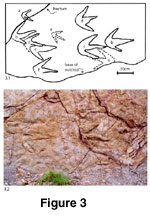TRACKSITE DESCRIPTION
 The undertracks described here lie on a tectonically tilted bedding surface that strikes 120º and dips
65º to the northeast, and occur in an area approximately 2 m wide by 5 m long
(Figure 3.1) in an inactive quarry 0.3 km east and 0.25 km north of the southwest corner of Section 9, R4E, T29S, in the Smeltertown TX-NM 7.5 minute quadrangle, on posted private property.
The undertracks described here lie on a tectonically tilted bedding surface that strikes 120º and dips
65º to the northeast, and occur in an area approximately 2 m wide by 5 m long
(Figure 3.1) in an inactive quarry 0.3 km east and 0.25 km north of the southwest corner of Section 9, R4E, T29S, in the Smeltertown TX-NM 7.5 minute quadrangle, on posted private property.
The prints are preserved in convex epirelief (1-5 cm) above the sandstone bed because they are actually sub-surface "undertracks"
(Lockley and Hunt
1995) or subsurface "compression shapes" (Brown
1999) preserved on a
bioturbated, hematized sandstone bedding plane that was once covered by a veneer of silty mud. Prints were likely produced by theropod dinosaurs (see
Taxonomy section below), who walked on the mud surface, compressing the sand below and leaving undertracks matching the size and depth of each track. The bio-compacted sand was more strongly
lithified, and thus today stands out in relief from the bedding plane.
Table 1 shows foot and pace lengths of the track-makers, as well as digit divarication angles, measured on the outcrop. Lettered tracks in
Figure 3.1 indicate individual dinosaurs, correlated to the track data in
Table 1. Also, some of the sub-surface compression shapes ("undertracks") include features called "pressure releases"
(Brown 1999) which support measurements of pace length and therefore relative speed of movement of the animals. For example, the pace length of dinosaur "b" is much longer than dinosaur "c," even though "c" has a longer foot length
(Table 1, Figure
3.1), indicating that animal "b" was moving more rapidly than was "c." This interpretation is supported by the presence of pressure releases of greater intensity, showing greater effort in maintaining forward motion
(Brown 1999). Thulborn (1990) noted structures within tracks that are distortions caused by nodes on the digits of the foot. However at this time,
it appears that the pressure releases are not simply distortion by the digital nodes.
In addition to the prints described herein, additional tracks of other dinosaurs and other reptiles have been found at several other locations in the area
(Kappus et al. in press).

 The undertracks described here lie on a tectonically tilted bedding surface that strikes 120º and dips
65º to the northeast, and occur in an area approximately 2 m wide by 5 m long
(Figure 3.1) in an inactive quarry 0.3 km east and 0.25 km north of the southwest corner of Section 9, R4E, T29S, in the Smeltertown TX-NM 7.5 minute quadrangle, on posted private property.
The undertracks described here lie on a tectonically tilted bedding surface that strikes 120º and dips
65º to the northeast, and occur in an area approximately 2 m wide by 5 m long
(Figure 3.1) in an inactive quarry 0.3 km east and 0.25 km north of the southwest corner of Section 9, R4E, T29S, in the Smeltertown TX-NM 7.5 minute quadrangle, on posted private property.